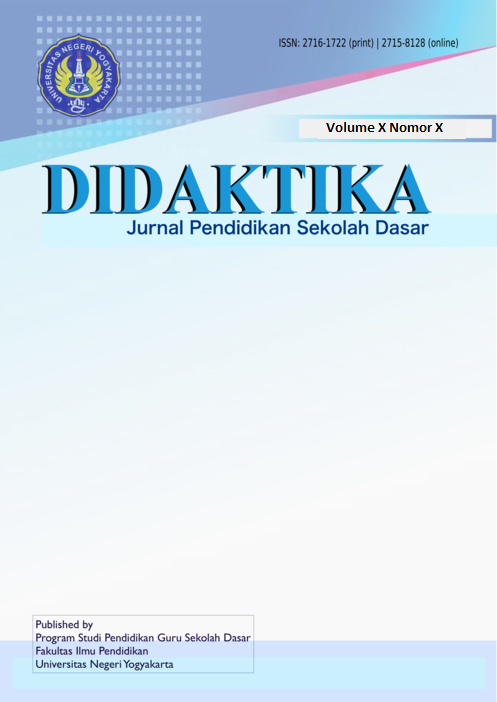Uji Kelayakan Pengembangan Buku Ajar Tematik Berbasis Inkuiri Kontekstual untuk Siswa Sekolah Dasar
DOI:
https://doi.org/10.21831/didaktika.v3i2.36165Abstract
This research aims to determine a thematic text book's feasibility based on elementary school students' contextual inquiry. The model used in the development is Dick & Carey, which has been simplified by the researcher into nine development stages as follows: (1) identifying objectives, (2) conducting learning analysis, (3) analyzing students and learning context, (4) formulating learning objectives, (5) developing assessment instruments, (6) developing learning strategies, (7) developing and selecting learning materials,( 8) conducting formative evaluations, and (9) product revisions. The product development then goes through a validation test by the material expert, design expert, and user expert by using different expert instruments. The result of the feasibility test has been analyzed descriptively. The result shows that the thematic textbook based on contextual inquiry with the percentage of feasibility from the material expert was 97,6% (valid), from design expert was 78,27% (valid), and from the user was 98,96% (valid). The result shows that the textbook which has been developed was feasible and can be implemented with little revision.
References
Akbar, S. (2015). Instrumen Perangkat Pembelajaran. Bandung: PT. Remaja Rosdakarya.
Amini, R. (2020). Textbook development on character-based active learning strategy using tournament type for elementary School student. Journal of Physics: Conference Series, 1567(4), 42036. IOP Publishing.
Borovay, L. A., Shore, B. M., Caccese, C., Yang, E., & Hua, O. (2019). Flow, achievement level, and inquiry-based learning. Journal of Advanced Academics, 30(1), 74–106.
Cheuk, K. P., Baškarada, S., & Koronios, A. (2017). Contextual factors in knowledge reuse. VINE Journal of Information and Knowledge Management Systems.
Depdiknas. (2004). Panduan Pengembangan Pembelajaran Tematik Terpadu. Jakarta: Depdiknas.
Depdiknas. (2013). Panduan Teknis: Memahami Buku Siswa dan Buku Guru dalam Pembelajaran di Sekolah Dasar. Jakarta: Kemendikbud.
Dick, W., Carey, L., & Carey, J. O. (2005). The systematic design of instruction.
Greenleaf, C., & Katz, M.-L. (2019). Releasing Responsibility for What? Developing Learning Environments for Text-Based Inquiry in the Disciplines in Secondary Schools. The Gradual Release of Responsibility in Literacy Research and Practice (Literacy Research, Practice and Evaluation, Vol. 10), Emerald Publishing Limited, 37–52.
Johnson, E. B. (2002). Contextual teaching and learning: What it is and why it's here to stay. Corwin Press.
Laxman, K. (2013). Infusing inquiry"based learning skills in curriculum implementation. International Journal for Lesson and Learning Studies.
Listianawati, L., Rusminto, N. E., Darsono, D., & Ambarita, A. (2018). Development of Thematic Textbook Based on Nation Culture and Character for 4th Grader Student. American Scientific Research Journal for Engineering, Technology, and Sciences (ASRJETS), 44(1), 278–289.
Prastowo, A. (2014). Pengembangan Bahan Ajar Tematik Tinjauan Teoritis dan Praktis. Jakarta: Kencana Prenadamedia Group.
Purwanti, A. D. (2012). Penerapan Pendekatan Kontekstual untuk Meningkatkan Minat Belajar Siswa pada Pembelajaran IPA di Sekolah Dasar. Jurnal Ilmiah Guru Caraka Olah Pikir Edukatif, 16(2).
Rismaningtyas, A., Slamet, A., & Pranoto, Y. K. S. (2019). Implementation of Contextual Based Teaching Materials on Various Work Themes of Primary School Students. Journal of Primary Education, 8(4), 110–119.
Santrock, J. W. (2011). Child Development. McGraw-Hill.
Sitepu, B. P. (2015). Penulisan Buku Teks Pelajaran. Bandung: Remaja Rosdakarya.
Trianto. (2008). Mendesain Pembelajaran Kontekstual. Jakarta: Cerdas Pustaka Publisher.
Voet, M., & De Wever, B. (2019). Teachers' adoption of inquiry-based learning activities: The importance of beliefs about education, the self, and the context. Journal of Teacher Education, 70(5), 423–440.
Webster New Dictionary. (1952). Chicago: Ferguson.
Downloads
Published
How to Cite
Issue
Section
Citation Check
License
- Authors retain copyright and grant the journal right of first publication with the work simultaneously licensed under a Creative Commons Attribution License that allows others to share the work with an acknowledgement of the work's authorship and initial publication in this journal.
- Authors are able to enter into separate, additional contractual arrangements for the non-exclusive distribution of the journal's published version of the work (e.g., post it to an institutional repository or publish it in a book), with an acknowledgement of its initial publication in this journal.
- Authors are permitted and encouraged to post their work online (e.g., in institutional repositories or on their website) prior to and during the submission process, as it can lead to productive exchanges, as well as earlier and greater citation of published work.






